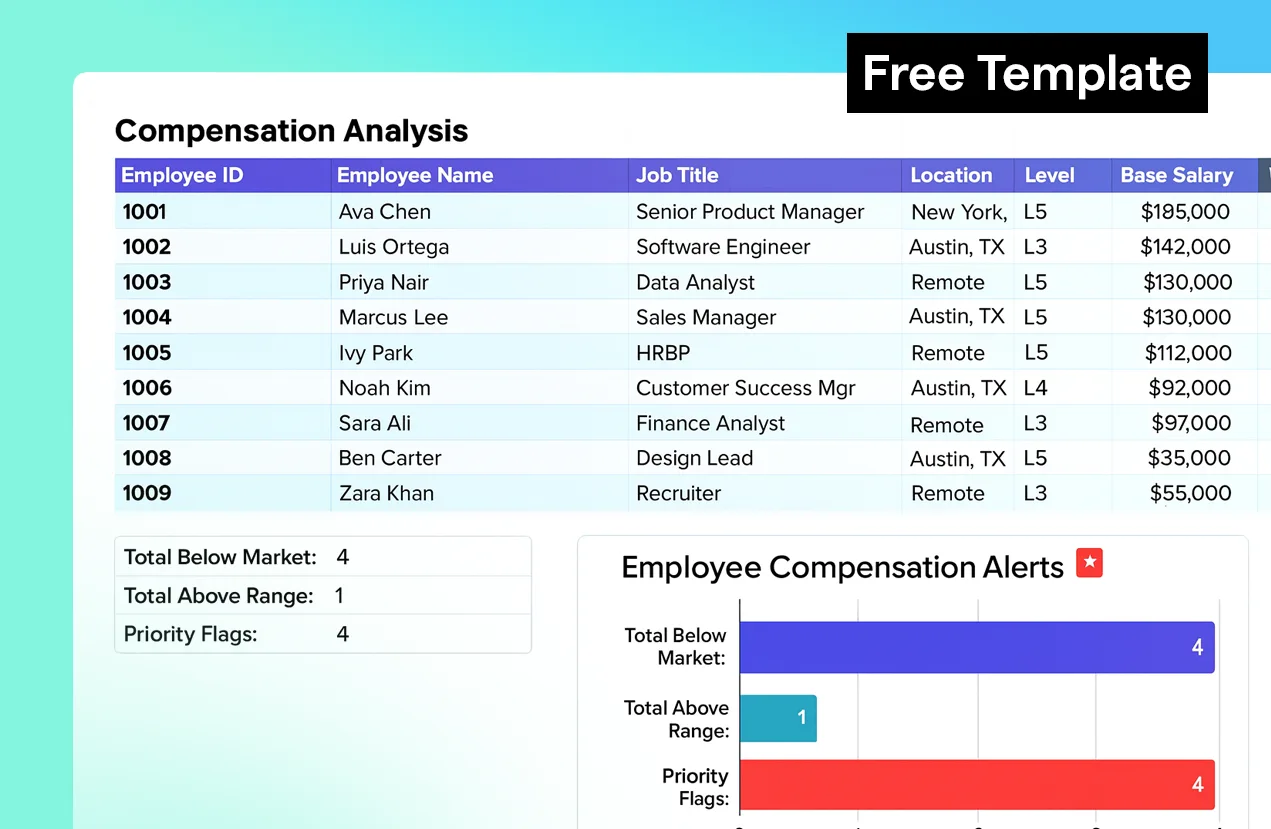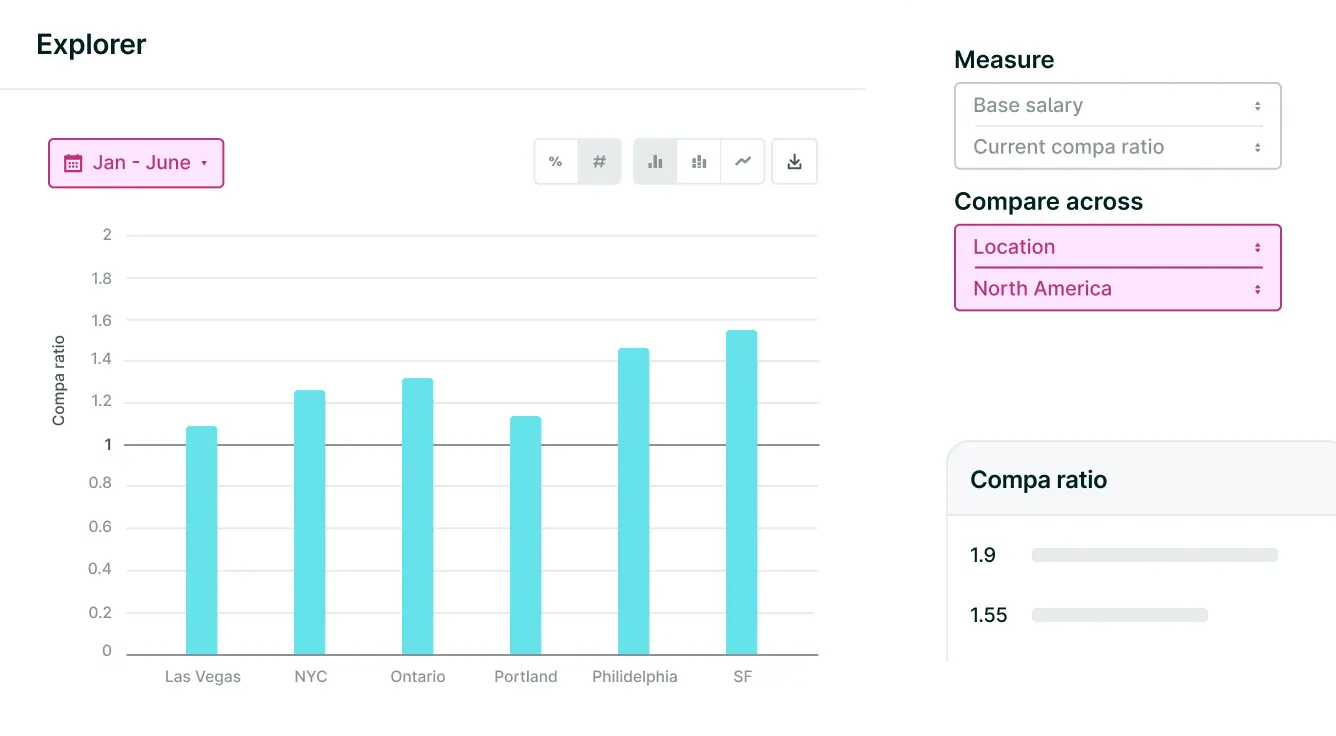When employees quit, two common reasons top the list: culture and compensation. While a great workplace culture might be hard to quantify, pay doesn’t have to be. That’s why HR teams need reliable tools to demystify compensation — not just to attract top talent, but to keep it.
In Lattice, you can access benchmarking data, salary bands, and analytics all in one place. But if you don’t have Lattice yet, we still got you covered.
Our free compensation analysis template is designed to help HR and finance teams understand how their current compensation stacks up across roles, levels, and departments. With built-in benchmarking and customizable formulas, this analysis template turns spreadsheets into strategy.
Let’s take a look at what’s inside, how it works, and how your team can use it to drive fair compensation, reduce turnover, and increase transparency.
Compensation Analysis Template
Get a data-driven view of your pay practices. This compensation analysis template is a ready-to-use Google Sheet that turns your compensation data into actionable insights. It comes equipped with formulas, visualizations, and customizable market comparisons to help HR and finance leaders compare employee pay to internal salary ranges and market rates, model budget impacts of proposed increases, and track base salary, equity, and employee benefits in one centralized location.

If you don’t have your own compensation software yet, this template is a powerful resource that streamlines your compensation plan and supports equitable decision-making. From compa-ratios to budget modeling, the template covers key aspects of compensation analysis. You’ll find:
- Range penetration visuals to see where employees fall within their bands
- Benchmark fields for inputting market compensation data
- Total compensation tracking for salary, equity, and benefits
- Priority flags to identify high-risk discrepancies or inequities
- A customizable settings tab for job title standardization and threshold adjustments
These built-in tools allow teams to visualize pay gaps, model raises, and make confident decisions, all in a single place.
Download Compensation Analysis Template
What Is Compensation Analysis?
Compensation analysis is the process of evaluating employee pay to ensure alignment with market rates, internal pay bands, and your overall compensation strategy. It’s both a diagnostic and a strategic tool: Companies use it to compare current salaries to industry benchmarks and assess whether their pay practices are equitable, competitive, and sustainable.
HR and finance teams who regularly conduct compensation analysis can identify inequities, adjust for disparities by gender, race, or level, and reward employees fairly for their work. The process also provides a framework for aligning pay with performance, tenure, and career growth. In a time when employee expectations around pay are rising, this kind of transparency and consistency supports both retention and employee satisfaction.
How Is Compensation Analysis Done?
A strong compensation analysis starts with good data and clear definitions. First, ensure all job descriptions are up-to-date and consistent across the organization. You can’t compare pay fairly if the roles themselves aren’t well-defined.
Next, gather complete compensation data from your HRIS or payroll system. This should include:
- Base salary
- Equity or stock options
- Bonuses and incentives
- Employee benefits
- Total compensation figures
Once your internal data is clean and structured, look outward. Use surveys, benchmarking tools, and market databases to understand how your pay compares to external standards. These benchmarks are critical for identifying misalignments between your compensation and the market.

With both internal and external data in hand, evaluate how each employee’s compensation compares to their salary range, peers, and the market. The Lattice compensation analysis template helps visualize these gaps using compa-ratios, range penetration scores, and flag systems that call out areas needing attention. From there, you can make data-informed adjustments to your pay structure, ensuring it supports fairness, equity, and competitiveness.
HR Problems That Could Be Solved with Compensation Analysis
Most HR teams conduct compensation analysis to address specific business challenges — not just for fun. Here are some key issues it can help resolve:
Benefits of Compensation Analysis
The benefits of compensation analysis go well beyond making spreadsheets easier to read. When you know where your company stands (and where the gaps are) you’re in a stronger position to make meaningful, lasting changes.
Here’s what your organization stands to gain:
- Identify flaws in your compensation structure, such as outdated ranges, overlooked roles, or systemic inequities.
- Attract top talent with transparent, competitive compensation offers and clear salary ranges.
- Improve morale by fostering trust and clarity around compensation decisions.
- Boost retention through equity-driven adjustments that reward tenure, impact, and performance.
- Reinforce transparency by tying your compensation practices to your values and DEIB goals.
Run Consistent and Fair Compensation Analyses with Lattice
Templates are a great place to start. But when you’re ready to go deeper, Lattice Compensation offers the infrastructure to manage compensation at scale.
In Lattice, HR teams can access dynamic benchmarking data, build custom salary ranges, and create flexible compensation bands that evolve with your organization. Compensation planning becomes centralized and collaborative — bringing together HR, finance, and executive stakeholders in one workflow.
You can build shareable dashboards, track budget usage in real time, and generate compensation statements that clearly communicate changes to employees. And because it integrates with Lattice Analytics and Performance, compensation isn’t a siloed process — it’s part of your broader people strategy.
Whether you’re refining your pay structure, updating your benefits package, or rolling out new stock options, Lattice gives you the insights and systems you need to move fast and do it right. Request a demo or tour Lattice Compensation today.
{{rich-highlight-1}}
✨ Disclaimer: This content was developed with the help of artificial intelligence, though reviewed, edited, and approved by (real) humans.



.webp)




